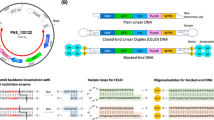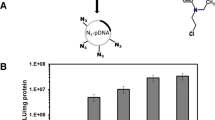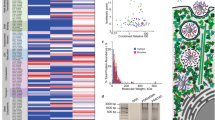Abstract
A simple and inexpensive method of condensing and linking plasmid DNA to carrier adenovirus particles is described. The synthetic polycation polyethylenimine is used to condense plasmid DNA into positively charged 100 nm complexes. These PEI–DNA complexes are then bound to adenovirus particles through charge interactions with negative domains on the viral hexon. The resulting transfection complexes deliver plasmid DNA to cells by the adenovirus infectious route without interference from virus gene expression because psoralen-inactivated virus is employed. The PEI–DNA–adenovirus complexes display DNA delivery comparable to more sophisticated DNA virus complexes employing streptavidin/biotin linkage, but require no special reagents and are much easier to prepare.
This is a preview of subscription content, access via your institution
Access options
Subscribe to this journal
Receive 12 print issues and online access
$259.00 per year
only $21.58 per issue
Buy this article
- Purchase on Springer Link
- Instant access to full article PDF
Prices may be subject to local taxes which are calculated during checkout
Similar content being viewed by others
Author information
Authors and Affiliations
Rights and permissions
About this article
Cite this article
Baker, A., Saltik, M., Lehrmann, H. et al. Polyethylenimine (PEI) is a simple, inexpensive and effective reagent for condensing and linking plasmid DNA to adenovirus for gene delivery. Gene Ther 4, 773–782 (1997). https://doi.org/10.1038/sj.gt.3300471
Received:
Accepted:
Issue Date:
DOI: https://doi.org/10.1038/sj.gt.3300471
Keywords
This article is cited by
-
Polyethylenimine-functionalized fibroin nanoparticles as a potential oral delivery system for BCS class-IV drugs, a case study of furosemide
Journal of Materials Science (2023)
-
Identification of G protein-coupled receptor 55 (GPR55) as a target of curcumin
npj Science of Food (2022)
-
A forward genetic screen identifies modifiers of rocaglate responsiveness
Scientific Reports (2021)
-
Analysis of the efficacy of HIV protease inhibitors against SARS-CoV-2′s main protease
Virology Journal (2020)
-
Nanotechnology based approaches for detection and delivery of microRNA in healthcare and crop protection
Journal of Nanobiotechnology (2018)



